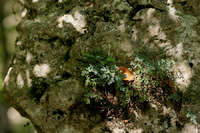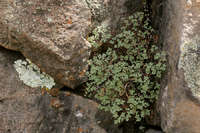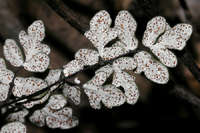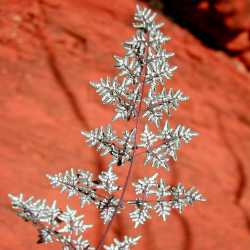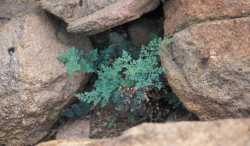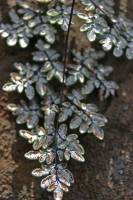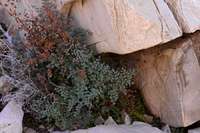Plants usually on rock. Stems compact, erect to ascending, usually unbranched; scales tan to brown, rarely black, concolored, subulate to narrowly lanceolate, margins entire. Leaves monomorphic, clustered, 3--30 cm. Petiole brown or black, rounded, flattened, or with single longitudinal groove adaxially, glabrous except for a few scales near base, with single vascular bundle. Blade lanceolate, ovate, or deltate, 2--6-pinnate, leathery to somewhat herbaceous, abaxially glabrous or covered by whitish farina, adaxially glabrous or sparsely glandular, dull, not striate; rachis straight or flexuous. Ultimate segments of blade stalked or subsessile, usually free from costae, elliptic to ovate or deltate, usually less than 4 mm wide; base often ± cordate, stalks lustrous and dark colored; segment margins plane or often recurved and forming confluent, poorly defined false indusia extending entire length of segment. Veins of ultimate segments free, usually obscure, pinnately branched and divergent distally. False indusia , when present, greenish, narrow, clearly marginal, occasionally concealing sporangia. Sporangia scattered along veins on abaxial leaf surface, often submarginal, containing 64 or 32 spores, usually intermixed with farina-producing glands. Spores brown, tetrahedral-globose, with cristate or rugose surfaces, lacking prominent equatorial ridge. Gametophytes glabrous. x = 27.
The species of Argyrochosma traditionally have been assigned to either Notholaena or Pellaea . Comparative studies (M. D. Windham 1987) have revealed that members of Argyrochosma are not closely related to Notholaena as typified by N . trichomanoides (Linnaeus) Desvaux. The two genera show consistent differences in stem and leaf morphology, sporangial distribution, spore color and ornamentation, chromosome base number, gametophyte morphology, and chemical composition of the farina.
Argyrochosma is more closely related to Pellaea (M. D. Windham 1987) and members of these genera are occasionally confused. These two groups are easily distinguished, however, based on the presence or absence of farina, leaf segment size and shape, and characteristics of the stem scales and leaf margins. In addition, all species of Argyrochosma thus far examined have a chromosome number based on x = 27, unique among cheilanthoid ferns. These differences suggest that Argyrochosma is monophyletic and worthy of recognition as a distinct genus.



